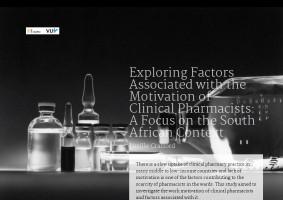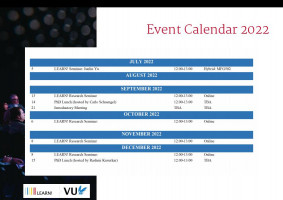There is a slow uptake of clinical pharmacy practice in many middle to low-income countries and lack of motivation is one of the factors contributing to the scarcity of pharmacists in the wards. This study aimed to investigate the work motivation of clinical pharmacists and factors associated with it.
There is a slow uptake of clinical pharmacy practice in many middle to low-income countries and lack of motivation is one of the factors contributing to the scarcity of pharmacists in the wards. This study aimed to investigate the work motivation of clinical pharmacists and factors associated with it. The theoretical framework used was the Self Determination Theory, and the motivation of clinical pharmacy graduates across South Africa was assessed with a survey and follow-up interviews. Higher amotivation was found in participants not practicing in dedicated clinical pharmacist positions, and those not receiving additional financial benefits for clinical services. The interviews revealed that relatedness and autonomy are the most important factors for their work motivation. To support clinical pharmacists, measures need to be taken to reinforce their sense of autonomy and relatedness.
A new publication by Lucille Crafford et al.
I am a joint PhD student, through Amsterdam UMC location Vrije Universiteit Amsterdam (Research in Education) and Sefako Makgatho Health Sciences in South Africa. My PhD focusses on the motivation and education of clinical pharmacists.
Recently, our first paper “Exploring Factors Associated with the Motivation of Clinical Pharmacists: A Focus on the South African Context” was published in Frontiers in Medicine. Why this topic? Motivation can be defined as the energy that drives an individual to accomplish a goal and positively influence work performance, whereas a lack of motivation has been identified as a key problem in human resources and delivery of quality healthcare services. Pharmacy practice in many middle to low-income countries has slowly transitioned from being product-focused to a more patient-focused clinical practice. Lack of motivation is one of the factors contributing to the scarcity of pharmacists in the wards however, little is known about their work motivation.
The theoretical framework for this study was the Self-Determination theory (SDT), which postulates that individuals have three basic psychological needs (BPNs), namely the need for autonomy, competence and relatedness. SDT has been applied effectively to examine what motivates individuals to work, however there is a scarcity of existing literature on work performance motivation and its determinants. Our study contributes to the literature by validating SDT in a target group that has not been studied before, and where motivation could be a key factor in establishing the success of clinical pharmacy.
Motivation is a dynamic entity and controlled motivation can change into autonomous motivation and vice versa depending on the degree to which BPNs [basic psychological needs] are being met.
The motivation of clinical pharmacy graduates across SA was assessed with a survey, including the Academic Motivation Scale and follow-up interviews. This study found high overall motivation among clinical pharmacists. The combination of high autonomous motivation (generated from within or through personal endorsement), as well as high controlled motivation (generated from external or internal pressure or rewards) raises a concern, as this combination according to SDT, is associated with burnout. Burnout, again leads to possible professional consequences like higher chances of quitting the field of work, and an overall negative effect on professional well-being and advancement of the clinical pharmacy profession.
This study further shows that there was higher amotivation, or absence of motivation, in clinical pharmacists currently not practicing in dedicated clinical pharmacist positions, and those not receiving additional financial benefits for delivering clinical services.
The post-hoc interviews later revealed that relatedness and autonomy are the most important factors for their work motivation. Feeling competent is crucial for autonomous motivation, and those not in dedicated positions, cannot optimally fulfil their role, leading to diminished professional autonomy. Furthermore, the lack of collegial support explained how the quality of their motivation, through feelings of relatedness, depends on the work environment.
Motivation is a dynamic entity and controlled motivation can change into autonomous motivation and vice versa depending on the degree to which BPNs are being met. The study findings demonstrate the existence of controlled motivation in clinical pharmacists and shows how the current work environment is driving controlled motivation, more than autonomous motivation. To support clinical pharmacists, measures need to be taken to reinforce their sense of autonomy and relatedness, by respectively providing them with opportunities to participate in decision-making and encouraging positive interactions with management and cooperation with colleagues.
A work environment where BPNs are fulfilled stimulate the most optimal type of motivation. This could also provide additional positive outcomes, such as enhancing motivation for lifelong learning. Continuing professional development sequentially helps health care professionals keep up with their changing context, positively affecting the quality of health care provided. These implications could also be interesting for other low to middle-income countries with a slow uptake of clinical pharmacy services.
_w400_h566_1.jpg)















